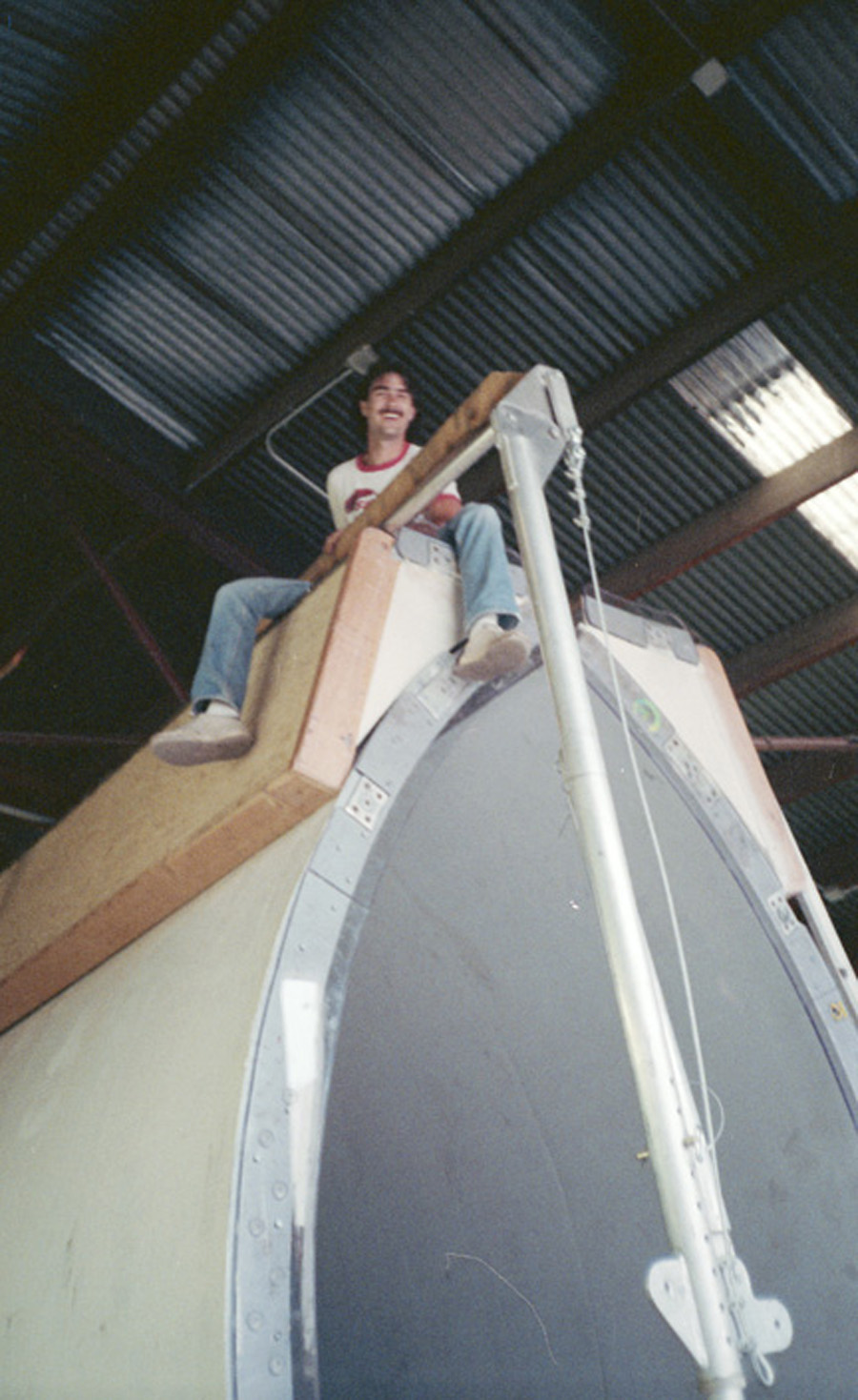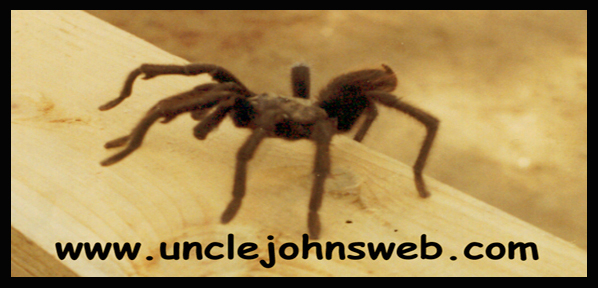
Chapter 16
Moby Ramp II
Two new guys got hired to beef up the Facilities crew for the upcoming factory move. They were friends Artie Corradi and Doug Adamski. I didn't know them before, but it doesn't take long for Deadheads to recognize each other, and these guys were avid. With my connections to the Grateful Dead ticket office, I could come up with tickets at the last minute for shows in California.
I remember when Artie first got his job at Powell; it was the second or third day, and he got a flat tire on the way to work, driving over from his sister's place in Ojai. The last thing he wanted to do at this point was to be late to work. Peter, our foreman, showed a gruff exterior to newcomers, and he had been putting Artie and Doug to the test. Artie got a flat tire somewhere on the 30-mile trip over Casitas Pass Road from Ojai to Gutierrez Street in Santa Barbara, and continued to drive until every shred of the tire was gone, and still he continued to drive down the back roads along foothills of Carpinteria and Montecito until he arrived at the Horton Building, right on time with the rim of one wheel a molten, smoldering ruin. Kept the job, though. That's how I'll always remember Artie.
His buddy Doug Adamski was overqualified for the miscellaneous unskilled tasks he was given, but he needed a job at the moment and was happy to find himself in a place where Grateful Dead was spoken. He could skateboard a little bit and I watched him struggle to get his chops together, but like me, he was getting banged up and never got committed to it. He left Powell after we had moved the company to its new digs, but we've stayed friends ever since.
The mobile ramp had been a big success in its first incarnation. The combination of the gooseneck fifth wheel trailer and the Ford F-250 had served its purpose, but just barely. It was too lightweight. The decision was made to cut off the gooseneck, and replace it with a standard pintle hook and lunette ring, so that a larger truck could pull it. It also needed a beefier set of axles with standard size tires we could replace anywhere.
A larger truck was a good idea for a few other reasons. The company bought a Peterbilt with a 20-foot box and a lift gate. The big box could be used to carry a decent collection of smaller skate elements for our demos, and quite a bit of our product as well. Big graphics of a Powell dragon were applied to the sides of it.
The ramp would just barely fit under the doorway of the Horton Building and it was squeezed inside so that Mike Frazier could do the cutting and welding for a different type hitch. Before you knew it, the gooseneck was cut off and lying on the ground and the tang of a beautifully welded lunette ring was integrated with the structure of the trailer in its place. James rerouted the lines for the hydraulic cylinders that operated the ramp's wings into a new compartment for the batteries and hydraulic pump. Once it was all put together, Joel was able to maneuver the rig out of the building with a forklift and into the backyard, across from the CrossBones halfpipe. For a short while, we had two usable halfpipes in the back lot.
Outside, we went to work on the ramp itself. A problem with the mobile ramp on the '88 Tour was that the 4 foot wide rollout platforms had to be lifted up and down from the aluminum tube struts and placed inside the folded up ramp on the flatbottom for travel. This was part of the grueling process of setup and tear down. It was determined that if we had a little narrower rollouts, they could be attached to the hinged part of the transitions, so that they would fold up and down as one piece, saving us the work of taking them off.
We came up with a structural design that would have narrower rollout platforms fold down against the convex outsides of the ramp. Once I had completed the woodwork, Ves used his skills to fiberglass the entire new structures for strength and waterproofing. Mike Frazier rebuilt the tubular aluminum struts that supported the whole works, and the railings on the rollouts. Ves sprayed the new steel with primer and white automotive paint like the rest of the chassis. We finally attached Lexan curbs to the edges of the skating surface to prevent loose skateboards from whacking somebody in the face...again. With that, mobile ramp version 2.0 was ready to hit the road.
With the new configuration, as a truck and trailer, one man could do the whole thing. And since the bigger rig required a commercial driver's license, Peter Edwards became the sole ramp master. In this capacity, he could drive anywhere in the country and set up a little skatepark, single handedly...and did, for years thereafter.
That was one of the last major projects we did at the Horton Building. Pretty soon Facilities would be consumed with the moving the entire company to Goleta.































I remember when Artie first got his job at Powell; it was the second or third day, and he got a flat tire on the way to work, driving over from his sister's place in Ojai. The last thing he wanted to do at this point was to be late to work. Peter, our foreman, showed a gruff exterior to newcomers, and he had been putting Artie and Doug to the test. Artie got a flat tire somewhere on the 30-mile trip over Casitas Pass Road from Ojai to Gutierrez Street in Santa Barbara, and continued to drive until every shred of the tire was gone, and still he continued to drive down the back roads along foothills of Carpinteria and Montecito until he arrived at the Horton Building, right on time with the rim of one wheel a molten, smoldering ruin. Kept the job, though. That's how I'll always remember Artie.
His buddy Doug Adamski was overqualified for the miscellaneous unskilled tasks he was given, but he needed a job at the moment and was happy to find himself in a place where Grateful Dead was spoken. He could skateboard a little bit and I watched him struggle to get his chops together, but like me, he was getting banged up and never got committed to it. He left Powell after we had moved the company to its new digs, but we've stayed friends ever since. The mobile ramp had been a big success in its first incarnation. The combination of the gooseneck fifth wheel trailer and the Ford F-250 had served its purpose, but just barely. It was too lightweight. The decision was made to cut off the gooseneck, and replace it with a standard pintle hook and lunette ring, so that a larger truck could pull it. It also needed a beefier set of axles with standard size tires we could replace anywhere. A larger truck was a good idea for a few other reasons. The company bought a Peterbilt with a 20-foot box and a lift gate. The big box could be used to carry a decent collection of smaller skate elements for our demos, and quite a bit of our product as well. Big graphics of a Powell dragon were applied to the sides of it.
The ramp would just barely fit under the doorway of the Horton Building and it was squeezed inside so that Mike Frazier could do the cutting and welding for a different type hitch. Before you knew it, the gooseneck was cut off and lying on the ground and the tang of a beautifully welded lunette ring was integrated with the structure of the trailer in its place. James rerouted the lines for the hydraulic cylinders that operated the ramp's wings into a new compartment for the batteries and hydraulic pump. Once it was all put together, Joel was able to maneuver the rig out of the building with a forklift and into the backyard, across from the CrossBones halfpipe. For a short while, we had two usable halfpipes in the back lot.
Outside, we went to work on the ramp itself. A problem with the mobile ramp on the '88 Tour was that the 4 foot wide rollout platforms had to be lifted up and down from the aluminum tube struts and placed inside the folded up ramp on the flatbottom for travel. This was part of the grueling process of setup and tear down. It was determined that if we had a little narrower rollouts, they could be attached to the hinged part of the transitions, so that they would fold up and down as one piece, saving us the work of taking them off.
We came up with a structural design that would have narrower rollout platforms fold down against the convex outsides of the ramp. Once I had completed the woodwork, Ves used his skills to fiberglass the entire new structures for strength and waterproofing. Mike Frazier rebuilt the tubular aluminum struts that supported the whole works, and the railings on the rollouts. Ves sprayed the new steel with primer and white automotive paint like the rest of the chassis. We finally attached Lexan curbs to the edges of the skating surface to prevent loose skateboards from whacking somebody in the face...again. With that, mobile ramp version 2.0 was ready to hit the road.
With the new configuration, as a truck and trailer, one man could do the whole thing. And since the bigger rig required a commercial driver's license, Peter Edwards became the sole ramp master. In this capacity, he could drive anywhere in the country and set up a little skatepark, single handedly...and did, for years thereafter.
That was one of the last major projects we did at the Horton Building. Pretty soon Facilities would be consumed with the moving the entire company to Goleta.
